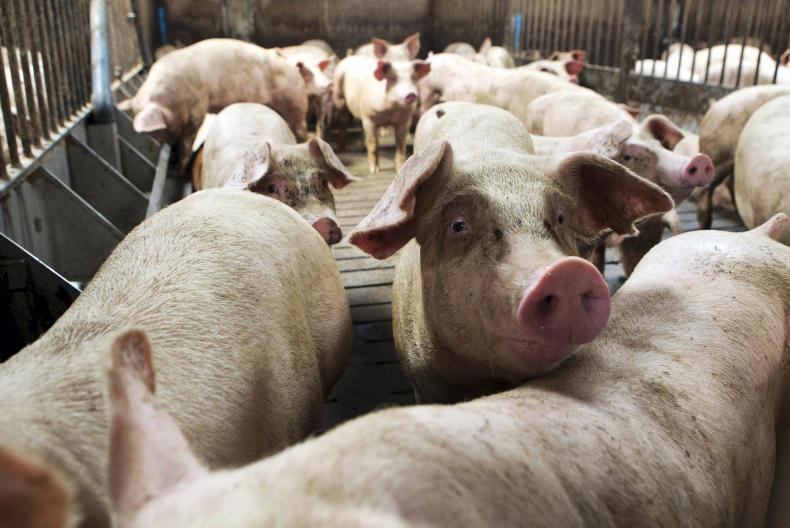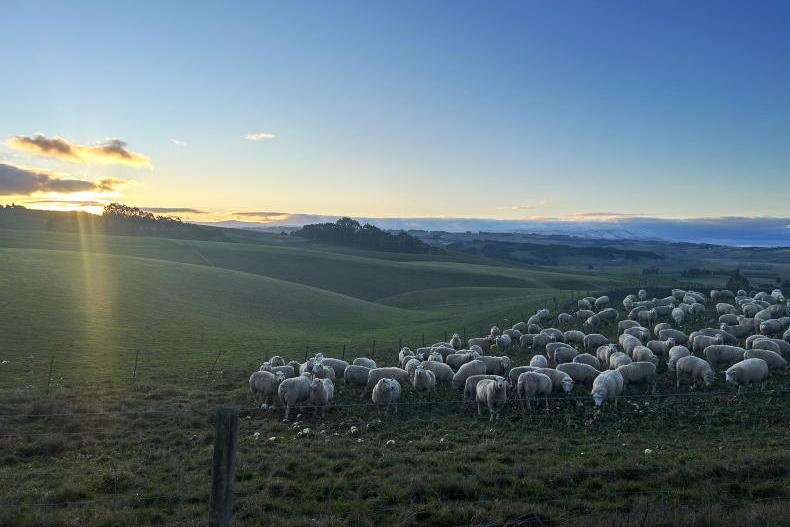Pig farmers have seen a remarkable improvement in their fortunes in 12 months and, with fingers crossed, they’re hoping 2020 will be even better. A year ago, they were on a loss-making price of €1.38/kg, today they’re on close to €2/kg and enjoying their highest profit margins in decades.
African swine fever (ASF) has forced China to cull 50% of its enormous pig herd. There are now 220m fewer pigs in China than in 2018. Its imports have lifted Irish prices, even though the bulk of Irish pigmeat is consumed on the home market and in the UK.
Pig farmers’ fingers are crossed because they’re very aware that one case of ASF here would see exports restricted – and prices tumble.
High demand to continue
Bord Bia has feet on the ground in China – and it sees pigmeat imports growing there. “In 2018, Chinese pig farmers produced over 53m tonnes of pigmeat and the country imported a further 1.5m tonnes,” says pigmeat market specialist Peter Duggan.
“In 2020, production will be reduced to 50% of that output. That will leave the country with a deficit of 27m tonnes. To put these figures in context, Ireland produces a total of 1.2m tonnes of all types of meat.”
Bord Bia expects that imports (excluding offal) could grow to a record high of 3.5m tonnes in 2020. “They would be even higher if further pigmeat was available, but it’s not,” Duggan says.
“So Irish prices are very firm. I’ve never seen a February price of €2/kg including VAT.” Consumption of meat will fall in China because of this lower availability, he says.
Best profits in 40 years
Teagasc is tracking profitability in the sector and the latest forecasts make pleasant reading. If Ireland can keep out ASF, the pig sector will experience one of its highest levels of profitability in 40 years, according to Teagasc pigs specialist Michael McKeon.
With demand from China to increase further this year and remain high in 2021 and 2022, pig prices here will continue to rise in 2020, “albeit at a slower rate than the 50% seen in 2019”. Average price will break the €2/kg barrier in 2020.
At 81c/kg (November 2019), margin over feed is now at its highest in 30 years of Teagasc records.
Therefore, allowing 50c/kg for non-feed costs, current profit margins of 31c/kg, €28/pig or €784/sow will be at least maintained in 2020. This profitability is badly needed, McKeon notes, as the average Irish pig unit lost €130,000 between 2018 and 2019.
Both McKeon and Duggan warn that the coronavirus scare could yet affect on pigmeat demand and prices.
Farmers reducing merchant debt
Fourteen months ago, there was a lot of concern about debt building up on pig units with owners unable to pay feed bills. Balances built up to six months unpaid. But mills stuck with their pig farmer customers in the hope that markets would turn – they had little choice. Interest has been accumulating. From last April, pig farmers were able to start paying down feed balances. “Most are now back to three months’ credit or better and it’s no longer a major issue for millers,” says IFA pigs secretary Robert Malone.
A rising number of pig units mill their own feed. They buy straights from wholesalers and must make payment on delivery. When price went below production cost, some of these pig farmers had to go to their banks to extend or increase term loans.
Teagasc has warned pig farmers to prioritise repayment of feed credit and short-term bank loans. Its figures show that, for a 500-sow to fattening unit, taking 90 days credit incurs interest payments of €20,500 per year.
Waiting for TAMS
Capital spending by pig farmers over the past three years has been restrained. With profitability restored that will change. A number of producers are at planning stage to increase fattening space.
They are hoping that the ceiling for TAMS investment in pig units will be increased from the current €80,000 to €200,000. An application to change Ireland’s rural development plan to allow this is awaiting European Commission approval.
Pig prices went from €1.38 last January to €1.96 this year.Ireland has 143,000 breeding pigs, sows and boars – CSO, June 2019.This was down 3.6% on a year earlier, reflecting the loss-making prices of late 2018.Sow numbers were down 10%.However, gilt numbers were 20.6% up on a year earlier.The total pig herd is 1.6m head.The number of breeding pigs has declined over recent decades.Output per sow has increased dramatically through improved genetics and husbandry.There are 390 commercial pig producers.
Pig farmers have seen a remarkable improvement in their fortunes in 12 months and, with fingers crossed, they’re hoping 2020 will be even better. A year ago, they were on a loss-making price of €1.38/kg, today they’re on close to €2/kg and enjoying their highest profit margins in decades.
African swine fever (ASF) has forced China to cull 50% of its enormous pig herd. There are now 220m fewer pigs in China than in 2018. Its imports have lifted Irish prices, even though the bulk of Irish pigmeat is consumed on the home market and in the UK.
Pig farmers’ fingers are crossed because they’re very aware that one case of ASF here would see exports restricted – and prices tumble.
High demand to continue
Bord Bia has feet on the ground in China – and it sees pigmeat imports growing there. “In 2018, Chinese pig farmers produced over 53m tonnes of pigmeat and the country imported a further 1.5m tonnes,” says pigmeat market specialist Peter Duggan.
“In 2020, production will be reduced to 50% of that output. That will leave the country with a deficit of 27m tonnes. To put these figures in context, Ireland produces a total of 1.2m tonnes of all types of meat.”
Bord Bia expects that imports (excluding offal) could grow to a record high of 3.5m tonnes in 2020. “They would be even higher if further pigmeat was available, but it’s not,” Duggan says.
“So Irish prices are very firm. I’ve never seen a February price of €2/kg including VAT.” Consumption of meat will fall in China because of this lower availability, he says.
Best profits in 40 years
Teagasc is tracking profitability in the sector and the latest forecasts make pleasant reading. If Ireland can keep out ASF, the pig sector will experience one of its highest levels of profitability in 40 years, according to Teagasc pigs specialist Michael McKeon.
With demand from China to increase further this year and remain high in 2021 and 2022, pig prices here will continue to rise in 2020, “albeit at a slower rate than the 50% seen in 2019”. Average price will break the €2/kg barrier in 2020.
At 81c/kg (November 2019), margin over feed is now at its highest in 30 years of Teagasc records.
Therefore, allowing 50c/kg for non-feed costs, current profit margins of 31c/kg, €28/pig or €784/sow will be at least maintained in 2020. This profitability is badly needed, McKeon notes, as the average Irish pig unit lost €130,000 between 2018 and 2019.
Both McKeon and Duggan warn that the coronavirus scare could yet affect on pigmeat demand and prices.
Farmers reducing merchant debt
Fourteen months ago, there was a lot of concern about debt building up on pig units with owners unable to pay feed bills. Balances built up to six months unpaid. But mills stuck with their pig farmer customers in the hope that markets would turn – they had little choice. Interest has been accumulating. From last April, pig farmers were able to start paying down feed balances. “Most are now back to three months’ credit or better and it’s no longer a major issue for millers,” says IFA pigs secretary Robert Malone.
A rising number of pig units mill their own feed. They buy straights from wholesalers and must make payment on delivery. When price went below production cost, some of these pig farmers had to go to their banks to extend or increase term loans.
Teagasc has warned pig farmers to prioritise repayment of feed credit and short-term bank loans. Its figures show that, for a 500-sow to fattening unit, taking 90 days credit incurs interest payments of €20,500 per year.
Waiting for TAMS
Capital spending by pig farmers over the past three years has been restrained. With profitability restored that will change. A number of producers are at planning stage to increase fattening space.
They are hoping that the ceiling for TAMS investment in pig units will be increased from the current €80,000 to €200,000. An application to change Ireland’s rural development plan to allow this is awaiting European Commission approval.
Pig prices went from €1.38 last January to €1.96 this year.Ireland has 143,000 breeding pigs, sows and boars – CSO, June 2019.This was down 3.6% on a year earlier, reflecting the loss-making prices of late 2018.Sow numbers were down 10%.However, gilt numbers were 20.6% up on a year earlier.The total pig herd is 1.6m head.The number of breeding pigs has declined over recent decades.Output per sow has increased dramatically through improved genetics and husbandry.There are 390 commercial pig producers. 









SHARING OPTIONS